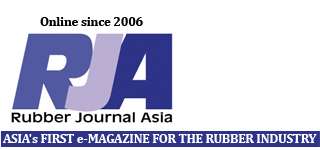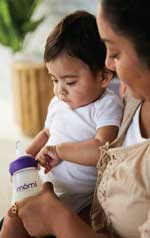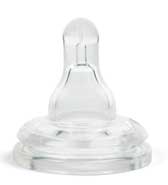In this case study, Canada-based LSR specialist Silcotech and medical device maker Momtech partnered to bring the momi baby bottle to market. The baby bottle nipple is said to ease infants’ transition to bottle feeding.
Anyone who has ever fed a baby can tell you it’s not necessarily easy, especially when the baby is transitioning from breastfeeding to bottle feeding.
In 2011, inventor Carr Lane Quackenbush set out to simplify the breast-to-bottle transition in partnership with serial entrepreneur Hal Eason, CEO/co-founder of Momtech, a company dedicated to providing new products for mothers and their babies.
Their efforts led to the 2023 arrival of momi baby nipples on the market and a much easier experience for babies making the breast-to-bottle transition.
Eason points out that this device was born out of game-changing liquid silicone rubber (LSR) processing brought to the table by the LSR experts at Canada’s Silcotech.
“We could never have gotten where we are without a true spirit of partnership with Michael (Silcotech President/co-founder Michael Maloney) and his team,” said Eason.
Joining forces
The momi journey began with Quackenbush, former President of a leading breast pump manufacturer, “retiring” to his personal workshop where he spent ten years designing and prototyping baby bottle nipples that could simulate the natural contours and function of a woman’s breast.
After six iterations of design and testing with small numbers of babies, Quackenbush approached Eason with a version he believed was market-ready.
Eason adds, “As simple as the product looked, it was the first of its kind in the market and presented a number of design challenges. It was not a slam dunk. In fact, Silcotech was the only company we found willing even to take it on.”
Simulating nature with technology
The momi nipple is rooted in the principle that nature is the gold standard of design and that current baby bottle technology is different from nature to a point where breastfed babies will either refuse to take a bottle or refuse to return to the breast should breastfeeding need to be interrupted.
“Every conventional nipple on the market is hollow, and that’s not natural,” Eason explained. “The fundamental differentiator of our product is that it has a solid soft silicone tip that resembles human tissue, enabling the baby to use the same oral mechanics whether being fed from the bottle or the breast.”
Silcotech was invaluable in navigating the various hurdles, starting with ensuring product safety.
Silcotech’s Maloney, adds, “It’s a highly regulated space, all focused on the ultimate effect on the baby. And then there are mechanical considerations, as well, such as the fact that babies eventually develop teeth. You have to make sure that when biting down on the nipple, the baby doesn’t break off a chunk that becomes a choking hazard.”
The effort to meet all the challenges set before the team led to a product that mixed three different types of LSR, a mixing process at which Silcotech is an expert.
“Implementing multiple materials within a single device was the only path we saw at the time to get the part to meet both the functional expectation and the safety requirements in creating a nipple that emulated more natural breast behaviour – allowing a baby to control the flow of milk through the duct,” Maloney explained.
Reaping the fruits of collaboration: the nipple
The three-material Gen 1 momi nipple proved a big success for the company, resulting in enthusiastic praise from users along with encouraging suggestions on how to make the product even better.
So is the continuing process of production and response, according to Maloney. “Product design is an iterative process. You need to develop a product to get out there in the market to see how they react, hear the feedback and then stay on your feet and move with whatever that feedback is. Our evolution went down that path and, as we learned, we were able to strip away some functionally that we thought we needed that we didn’t, and it was all based on true feedback from the field and genuine physical testing.”
“We found out that the geometry of the Gen 1 nipple, while getting its intended job done very well, led to suboptimal oral function for some babies,” said Eason. “In Gen 2, we were able to adjust the geometry while also reducing the number of LSRs used from three to one. We’re looking forward to even more improvement in Gen 3.”
While all of the adjustments made along the way seem matter-of-fact in hindsight, the road wasn’t uniformly smooth.
Echoing Thomas Edison’s sentiments about the importance of discovering what doesn’t work on the path to discovering what does, Maloney said, “The acceptance of failure and the ability to fail fast is critical, because the reality is that success requires iterations of failure. The more often you can fail the more likely you are to succeed. Don’t get bogged down by bumps in the road as you’re travelling to your path of success.”
Expounding on the benefits of a good personality mix, Eason added, “You have to have the right people in the boat. There are programmes that we’ve walked away from because of character and integrity issues.”
The Momtech/Silcotech collaboration has been a shining example of how to successfully manage multiple creative minds to bring a product to fruition after the invariable multiple rounds of design iterations.
As a result, momi baby nipples are helping many thousands of mothers and babies enjoy a stress-free transition between breastfeeding and bottle feeding.
Safe and sustainable materials take hold of the baby care market
Needless to say, the use of LSR in baby care products has gone past its teething stage: it is here to stay, as its application is expanding rapidly due to growing demand for safer, longer-lasting, and more hygienic options. LSR has become a preferred material for items like bottle nipples, pacifiers, and teething rings because it is non-toxic and free from harmful substances. Its biocompatibility, hypoallergenic properties, and resistance to heat and cleaning agents make it ideal for daily use and repeated sterilisation.
By 2030, the LSR market across various applications is projected to reach 386 kilotonnes, growing at a compound annual growth rate (CAGR) of 6.9% from 2025, when it is estimated to be 276 kilotonnes, according to Mordor Intelligence’s LSR market share analysis.
Looking further ahead, the market is expected to expand from nearly US$3.6 billion in 2025 to US$11 billion by 2037, based on Research Nester’s Liquid Silicone Rubber Market Size, Growth Report 2037.
The baby care and healthcare industries are anticipated to capture a larger share of this market in the coming years. However, growth may be constrained by the relatively high cost of LSR as a material.
Moreover, the LSR market for baby care is expected to witness significant growth across several key regions, driven by rising demand in the healthcare and baby care sectors, ongoing technological advancements, and supportive government initiatives. One such initiative is China’s 2021–2025 action plan for improving child health, which is expected to further boost demand for LSR in the years ahead, according to Mordor Intelligence.



